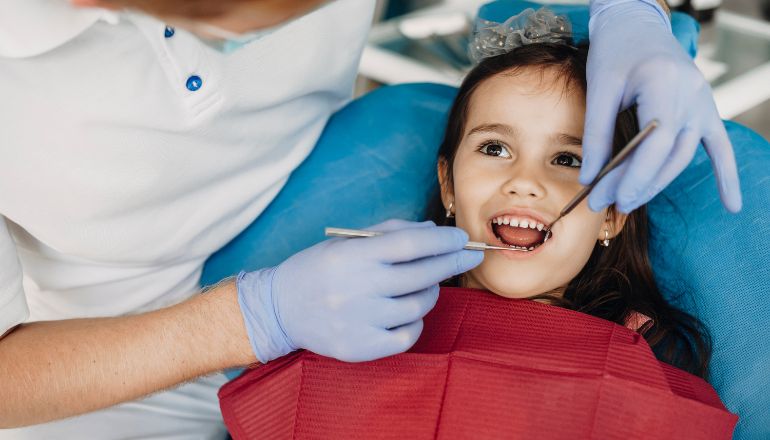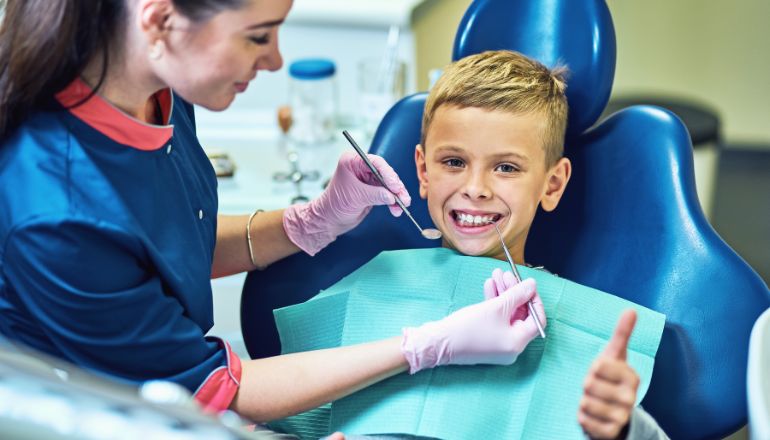Author: Dr.Ambily Mathew (General Dentist – WELLKINS Medical Centre)
Tooth Decay or Dental Caries remains the most prevalent chronic disease in both children and adults though it is largely preventable. The World Health Organization (WHO) reports that 60 to 90 % of people are affected by dental caries. More than half of children aged 6 to 8 have had a cavity in atleast one of their baby teeth.
What are the causes of tooth decay in young children?
Tooth decay is the result of bacteria that are normally present on our teeth interacting with sugars that we consume in our daily diet. The bacteria use the sugars to produce acid and over a period, the acid destroys the tooth enamel (the hard surface of your tooth) resulting in tooth decay. At first, tooth decay may not cause any obvious symptoms, but as it progresses, can result in toothache and sensitivity to hot, cold and sweet foods and drinks. If the decay spreads further to the nerve, it can lead to infection, or worse, result in an abscess on the gum causing severe pain, swelling of the jaw, and fever. In young children, tooth decay most often affects upper front baby teeth first, then later can appear on upper and lower back baby teeth. Lower front baby teeth are rarely affected.

What are the signs and symptoms of Early Childhood caries (ECC)?
Early Childhood caries (ECC) formerly known as nursing bottle tooth caries refers to tooth decay in children under the age of six.This caries develop over time and its difficult to see in early stages. Tooth decay may show as:
- A dull white band on the tooth surface closest to the gum line – this is the first sign and usually remains undetected by parents
- A yellow, brown or black band on the tooth surface closest to the gum line – this indicates progression to decay
- Teeth that look like brownish-black stumps this indicates that the child has advanced decay.
Preventing early tooth decay in children requires establishing good oral hygiene habits. Encourage regular brushing with fluoride toothpaste, limit sugary snacks and drinks, and schedule regular dental check-ups. Consider dental sealants and discuss fluoride supplements with the dentist. These simple steps can help protect children’s teeth and promote long-term oral health.
Is tooth decay preventable?
Yes, it is preventable. While fluoridated drinking water and fluoride-containing toothpaste have helped to improve the oral health of children, regular tooth brushing, and a well-balanced diet are just as essential to prevent tooth decay. Also, once a month, advise parents to lift their child’s lip to check for decay by looking for white or brown spots on the upper teeth near the gums.
How can I take care of my baby’s teeth?
Tooth decay can be prevented if you take the right steps at the right time.
- Start dental home care at an early age Before their teeth come in, you can clean babies’ gums with a clean, damp facecloth or use a soft baby brush. This removes plaque buildup even before teeth emerge. Once the teeth do come in, brush with a soft-bristled toothbrush twice a day for two minutes.
- Monitor the amount of sugar intake Sugar foods are the number one cause of decay. Limit the amount of candy ,juice and other sugar foods your child eats.If you do give dried fruits and juice to your child, try to limit the amount and brush or rinse after eat or drinking them.
- Provide toddlers with healthy foods While it is important to avoid foods that cause cavities, it is also important to eat plenty of healthy foods that keep your teeth clean and strong and reduce the risk of tooth decay. Foods to embrace include eggs ,sweet potatoes ,yogurt ,cheese, avocados, beans and fibrous vegetables. These foods are rich in vitamins and minerals that balance oral ph to keep cavity causing bacteria at bay and help to keep them shiny. According to American Dental Association (ADA) the most troublesome foods include citrus fruits like lime ,oranges which contain abrasive acids that can erode teeth enamel.
- Drink plenty of water Drinking plenty of water is a potent way of keeping cavities away. Water help washes away food residue, flushes bacteria and prevents acid buildup. Encourage your child to drink plenty of water
- Choose the right toothpaste in the right amount Fluoride toothpaste is the right choice. For children younger than three years old use only a small amount of toothpaste about the size of a grain of rice. Starting at age three your child can use a pea-sized amount of paste.Try to floss your child’s teeth daily after age two.
- Supervise younger kids Supervision during brushing ensures no food gets left behind that could start cavities. The kids may not be able to see as they brush. Another pair of eyes can spot anything they miss.
- Set a good example Let your kids see that you practice what you say. Take care of your own oral health and let them see you do it. Your kids model their behaviour after yours. Brush and floss regularly to reinforce how important oral health is. Make brushing a family event to let the kids know everyone brushes before going to bed.
- Make regular appointments with dentist a habit The first dental visit should be at the age of one so the dentist can provide the right educational advice, according to the stage of development and assess risk factors early.Prevention is the key.

What are the best preventive dental care treatments available for my child?
Fluoride Treatment: Fluoride treatments are usually offered during your child’s professional teeth cleaning sessions as a final step. They are a very important preventive treatment option, especially for kids. It only takes a few minutes to apply the fluoride and offers long-term protection against cavities until your child’s next appointment in six months.
Dental Sealants: Dental sealants are a favourite preventive treatment amongst dentist and the most effective preventive care treatment choice for kids.They provide longterm cavity protection by forming a physical barrier on your child’s most vulnerable teeth. Dental sealants are a plastic coating placed on your child’s molars, which are the teeth most vulnerable to deep, damaging cavities. Once in place, properly applied dental sealants last for years! During the first two years, they protect against 80% of cavities. By year four, they still stop 50% of cavities.
How is tooth decay treated in a child?
Treatment will depend on your child’s symptoms, age, and general health. It will also depend on how severe the condition is. In most cases, treatment requires removing the decayed part of the tooth and replacing it with a filling. Fillings are materials placed in teeth to repair damage caused by tooth decay. They are also called restorations. There are different types of fillings:
Direct restorations These need a single visit to place a filling directly into a prepared cavity. These fillings may be made out of fine glass powders, acrylic acids, or resin. They are often tooth-colored.
Indirect restorations These may require two or more visits. They include inlays, onlays, veneers, crowns, and bridges. These are constructed with g, base metal alloys, ceramics, or composites. Many of these materials can look like natural tooth enamel.
Pulpectomy It is used to save and repair an infected or decayed tooth. It is a root canal procedure which involves removing the nerve and pulp of the tooth. The inside of the tooth is then cleaned and sealed.
Why is it important to take care of baby teeth?
Baby teeth are actually very important and are at risk of tooth decay soon after they appear in the mouth, usually from around four months of age. Children need strong, healthy teeth to chew their food, speak clearly and have a goodlooking smile. They also maintain correct spacing in the jaw for the adult teeth. If a child loses a baby tooth prematurely, the teeth beside it may drift into the empty space. So, when it’s time for their adult teeth to come through, particularly if it is a few years after the baby tooth or teeth have been removed, there might not be enough room, leading to crooked teeth and crowding.
Empowering children to look after their teeth at an early age means they’re more likely to care for them later in life.
Let your child’s healthy smile be your life’s greatest asset!!
Check out the dental procedures we do at WELLKINS here : Dental Care






